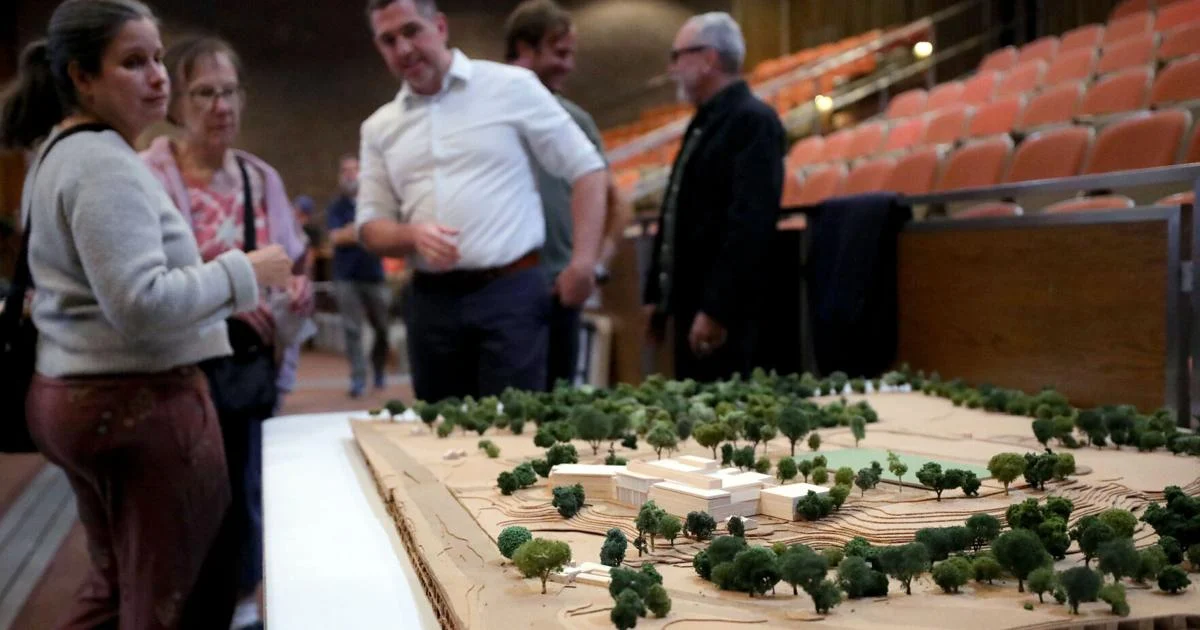How much will taxpayers pay? We answer your commonly asked questions about Monument Mountain Building Project
By By Talia Lissauer,Stephanie Zollshan — The Berkshire Eagle,The Berkshire Eagle
Copyright berkshireeagle

GREAT BARRINGTON — When the Monument Mountain Building Project committee hosted a public tour and information session at the high school on Tuesday, residents asked questions like:
“What happens if the project fails?”
“The state has a repair program. Why aren’t we eligible for that?”
“How soon would property taxes go up if the building project is approved?”
Those questions came after a tour of the nearly 60-year-old high school and a look at plans for a proposed $152 million replacement. Local taxpayers would be responsible for $89 million, with the remaining $61 million covered by the Massachusetts School Building Authority.
Serving students from Great Barrington, Stockbridge and West Stockbridge, Monument Mountain Regional High School needs an upgrade. But voters will decide if that means constructing a new, state-of-the-art building. For the project to move forward, a simple majority of votes across all three towns combined is required — not separate majorities in each town.
The nearly 60-year-old building needs a new roof, boilers, plumbing and electrical system, according to the committee. The building also suffers a lack of natural light and ventilation, insufficient security measures and an upgrade to education materials.
With the support of the state’s School Building Authority funding — which is granted after an extremely competitive process where districts must demonstrate an educational and facility need for an upgrade — the committee has put forth a plan for a three-story, all-electric school that will be built to be net zero-ready with a secure main entrance and a major upgrade to career technical opportunities.
Historically, Monument Mountain building projects have faced opposition from the community, largely over high costs and the long-term impact on taxpayers.
After Tuesday’s presentation, committee members fielded a range of questions. Here are their answers to the three most common.
Are taxpayers on the hook for $89 million no matter what?
Not exactly, but taxpayers are likely to face significant costs either way.
If voters approve the project in November, the price tag is $152 million: $61 million from the Massachusetts School Building Authority, $1.5 million from MassSave and $89 million from local taxpayers.
If voters reject the project and the building instead undergoes maintenance, the committee estimates those repairs to be around $89 million as well. But that number is an estimate and could rise over time because the work would be done in phases and costs are likely to increase.
The district could temporarily reduce expenses by choosing which repairs to do first and spreading them out over several years, but delaying some projects could make them more expensive later.
If the district starts over and tries to design a cheaper school, it is unlikely the MSBA would agree to fund it after multiple failed votes, so the community would likely have to cover the full cost on its own.
Additionally, MSBA does have an accelerated repair program, but this school doesn’t qualify because it is currently “not meeting the educational needs of the students.” If the committee were to propose another version of the project without, or with fewer, enhanced vocational opportunities or other cost-saving measures, it would likely not meet the educational needs of the students — meaning it would not qualify for the MSBA’s new building program either.
The committee’s bottom line: Taxpayers will probably spend roughly the same to repair the old school as to build a new one — but only the new school comes with state aid and a modern facility.
Why not remodel the current building?
Repairing the existing school would not qualify for state funding because the building no longer meets students’ educational needs.
Costs aside, repairing the current building would be the most disruptive option for students. The committee said it is not a viable long-term solution because of its outdated infrastructure. The process would take five to 10 years, require portable classrooms and still leave students learning in an outdated building.
The current school building would remain open during construction of the new school building. Once the new school is open in 2029, the old one would be torn down and the space will be turned into a practice field.
The building, which is nearly 60 years old, cannot support modern educational and safety standards. Repairing major systems, like the roof, plumbing and electrical, would not create a modern learning environment. The school’s layout does not support hands-on vocational learning, which the district considers an important priority. Repairs also would not address limited natural light and ventilation, issues students highlighted during tours that they said impact their learning.
Despite efforts to maintain it, the school is at the end of its natural life. The plumbing and electrical systems are out of date and there are insufficient security and safety features because the building was built in 1968. As the building continues to age, more issues will arise, and the committee says costs will continue to accumulate, making a new building a more sustainable long-term solution.
What is different this time than the last vote?
Upgrades to the school have been in the works for 15 years and this will be the third chance for voters to approve a project partially funded by the MSBA.
In 2014, two renovation proposals were put forward. Stockbridge and West Stockbridge passed them, but Great Barrington, the largest town in the district, voted down the plan. Committee members have said it’s a big deal that the district has been given another shot with the MSBA and it is unlikely that MSBA will give the district another opportunity in the next few decades.
Since 2014, committee members say a slew of changes have been made.
The building itself is now 11 years older and is getting harder and more expensive to maintain. Superintendent Peter Dillon said there is a clearer understanding of the educational, safety and sustainability needs that have led to a broader level of support from the community for a new building.
The regional agreement that governs the district has been reworked, and the district also attempted a merger with Southern Berkshire Regional School District last year, though it failed. Dillon said it showed the district has tried different approaches to dealing with the old building, like merging high schools.
The district has also developed a more ambitious vision for what the high school should offer. The current proposal includes expanded vocational and technical education opportunities. The district has state approval to launch a new electricity program in the proposed building and is planning additional pathways in advanced manufacturing, business and health and medical science.



